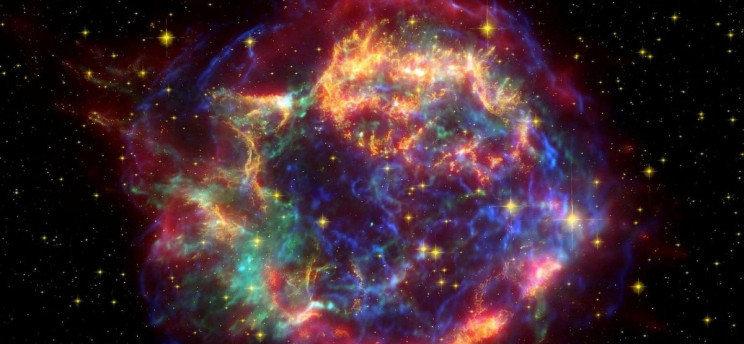It could even be a supernova chain reaction, who knows.

Imagine sitting in a park at night, bathed in the light of a supernova explosion, reading a novel... On cloudless nights, it will be slightly brighter than the full moon. But then you can neither read nor enjoy the scenery, and you will only die because of the radiation.
Illustration: This record-breaking explosion of brightness in a distant galaxy may be the first known example of a "pulsating pair-unstable" supernova (the artist's general interpretation of supernovae)
Scientists believe that this situation has led to at least one mass extinction event. Moreover, the detection of certain radioisotopes on Earth could be a way to confirm this hypothesis.
A study published in the Proceedings of the National Academy of Sciences found that a mass extinction 359 million years ago was most likely caused by an astronomical event.
The team focused its research primarily on the transition period between the Devonian and Carboniferous periods, where signs of ultraviolet burns were found on many generations of plant spores during this period, which could be a marker of a prolonged period of ozone depletion
Where does the ozone layer go?
The study's leader, a professor of astronomy and physics at the University of Illinois, told the Physicists Network: "Earth disasters such as massive volcanic activity and global warming can also destroy the ozone layer, but the evidence for time intervals is insufficient." He added: "However, if we assume that one or more supernovae explode 65 light-years away, long-term ozone layer destruction is possible." ”
Graduate co-author Adrian Eltel points out that Betelgeuse is one of our closest supernova threats, it is more than 600 light-years from Earth, and we are still 25 light-years away from its "killing range."
Related Reading: Will Betelgeuse embark on a journey to supernovae?
The team also investigated other causes that could cause such massive ozone depletion: meteorite impacts, solar eruptions and gamma-ray bursts. Another graduate co-author, Jesse Miller, added: "... These events ended quickly and were unlikely to cause long-term ozone depletion that occurred at the end of the Devonian period. "
However, supernova explosions could be a good explanation for this long-term ozone depletion. Exploding stars immediately produce large amounts of radiation ultraviolet, X-rays, and gamma rays. Such events could damage the Planet and its ozone layer for up to 100,000 years.
Multiple supernovae?
There's another interesting thing in that. Fossil evidence suggests that the decline in biodiversity lasted for about 300,000 years. This means that we may have experienced many catastrophic events. It could even mean multiple supernovae exploding in a cluster. Miller thinks the idea is possible: "Massive stars usually congregate with other massive stars, while other supernovae are likely to explode continuously shortly after the first explosion."
How do you prove it?
To prove this whole hypothesis, the team said, we need to find the radioactive isotopes plutonium-244 and samarium-146 in rock and fossil samples deposited during the mass extinction. As co-author Liu Zhenghai (homologous) points out, "None of the isotopes on Earth today are naturally produced, and the only way they come to Earth is through explosions in the universe." "Because over time, they decay," like a smoking gun, Fields said.
At the end of the conversation, Fields said something thought-provoking: "The first message of this study is that life on Earth doesn't exist in isolation, that we're citizens of a larger universe that influences our lives — often unconsciously, and sometimes with unusual ferocity." ”
BY: Utku Kucukduner
FY: Two cloths
If there is any infringement of the relevant content, please contact the author to delete it after the work is published
Please also obtain authorization for reprinting, and pay attention to maintaining completeness and noting out